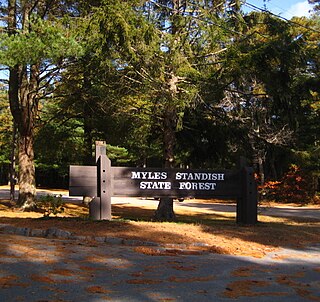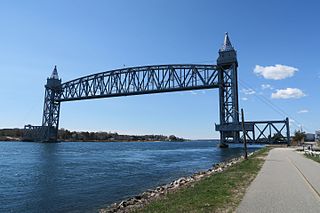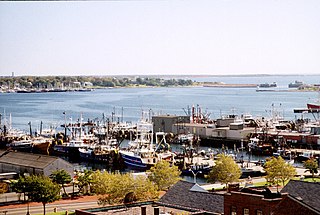
The Wankinco River is a 7.3-mile-long (11.7 km) [1] river in eastern Massachusetts, United States. It is a tributary of the Wareham River, which drains into Buzzards Bay.

A river is a natural flowing watercourse, usually freshwater, flowing towards an ocean, sea, lake or another river. In some cases a river flows into the ground and becomes dry at the end of its course without reaching another body of water. Small rivers can be referred to using names such as stream, creek, brook, rivulet, and rill. There are no official definitions for the generic term river as applied to geographic features, although in some countries or communities a stream is defined by its size. Many names for small rivers are specific to geographic location; examples are "run" in some parts of the United States, "burn" in Scotland and northeast England, and "beck" in northern England. Sometimes a river is defined as being larger than a creek, but not always: the language is vague.

Massachusetts, officially the Commonwealth of Massachusetts, is the most populous state in the New England region of the northeastern United States. It borders on the Atlantic Ocean to the east, the states of Connecticut and Rhode Island to the south, New Hampshire and Vermont to the north, and New York to the west. The state is named after the Massachusett tribe, which once inhabited the east side of the area, and is one of the original thirteen states. The capital of Massachusetts is Boston, which is also the most populous city in New England. Over 80% of Massachusetts's population lives in the Greater Boston metropolitan area, a region influential upon American history, academia, and industry. Originally dependent on agriculture, fishing and trade, Massachusetts was transformed into a manufacturing center during the Industrial Revolution. During the 20th century, Massachusetts's economy shifted from manufacturing to services. Modern Massachusetts is a global leader in biotechnology, engineering, higher education, finance, and maritime trade.
Although now spelled Wankinco, it was previously written as Wankinquoah, which may have been derived from Wonqun, meaning "crooked".
The river originates at East Head Reservoir, a pond in the Myles Standish State Forest, and flows southwards through various impoundments and cranberry bogs to join the Agawam River near the center of Wareham, Massachusetts, after which it forms the Wareham River, forming Wareham's main harbor with a depth of about 12 feet (3.7 m). During a portion of its course, it serves as the boundary between Carver and Plymouth, Massachusetts.
East Head Reservoir, also known as East Head Pond, is a 92-acre (370,000 m2) pond in Carver and Plymouth, Massachusetts, within the Myles Standish State Forest, located northeast of the forest headquarters, east of Barrett Pond, southwest of New Long Pond and College Pond, and northwest of Fearing Pond. The reservoir is the headwaters to the Wankinco River.

Myles Standish State Forest is state forest located in the towns of Plymouth and Carver in southeastern Massachusetts, approximately 45 miles (70 km) south of Boston. It is the largest publicly owned recreation area in this part of Massachusetts and is managed by the Department of Conservation and Recreation (DCR).

Cranberries are a group of evergreen dwarf shrubs or trailing vines in the subgenus Oxycoccus of the genus Vaccinium. In Britain, cranberry may refer to the native species Vaccinium oxycoccos, while in North America, cranberry may refer to Vaccinium macrocarpon. Vaccinium oxycoccos is cultivated in central and northern Europe, while Vaccinium macrocarpon is cultivated throughout the northern United States, Canada and Chile. In some methods of classification, Oxycoccus is regarded as a genus in its own right. They can be found in acidic bogs throughout the cooler regions of the Northern Hemisphere.















